
Station Name: LIVERPOOL CROWN STREET[Source:
Paul Wright]
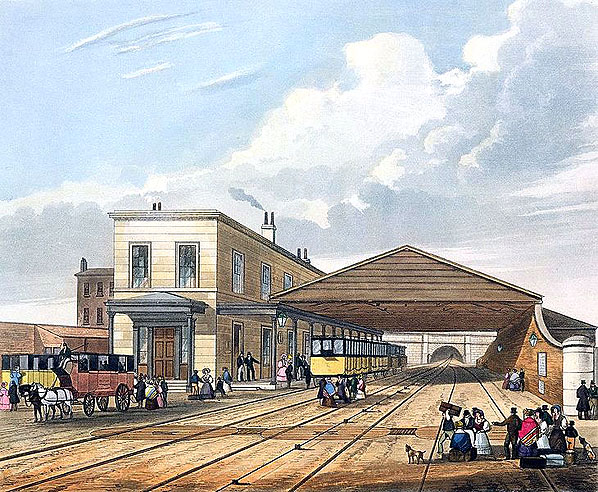 Liverpool Crown
Street station looking east in 1831. The layout of the station is clearly shown. To the left a train can be seen standing at the departure platform which is adjacent to the main building and all of the stations facilities. The train has no locomotive as it will work down to the Edge Hill cutting by gravity via the Crown Street tunnel which can be seen beyond the station. Trains were worked from the Edge Hill cutting by a cable which can be seen in the centre of the middle line. The arrival platform is to the right and passengers can be seen making their way from it to waiting omnibuses that would transport them to the city centre.
Painting by Thomas Bury 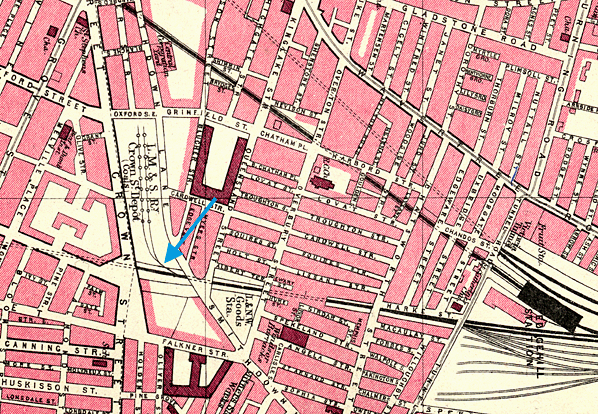 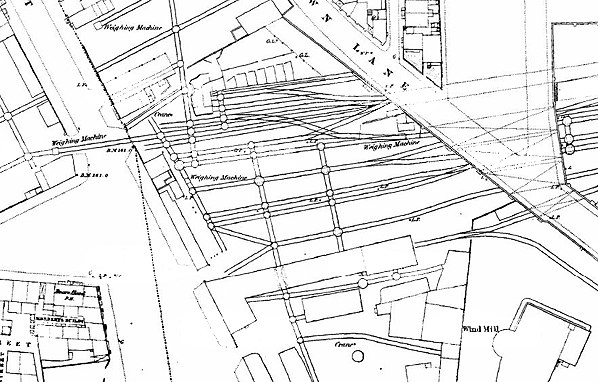 Crown Street station shown on a 1849 town plan thirteen years after the passenger station had closed. Nothing survived of the original terminus which was propably demolished shortly after closure. The 1829 Crown Street tunnel is shown on the plan with lines fanning out from its western portal. The lines to the south of the tunnel accessed Crown Street via a double track tunnel that had recently opened. 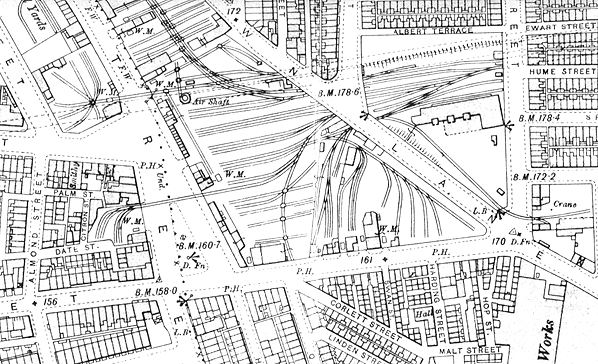 Liverpool Crown Street station shown on 1:2,500 scale map from 1905. As a goods station Crown Street had been expanded massively compared to how it was in 1849. The passenger station had been to the east of the air shaft that is marked on the map. The shaft was built in 1895 and served the 1829 Wapping tunnel. The installation of the shaft alonfg with four others allowed steam locomotives to work through the tunnel for the first time. 2.jpg)
The site of the Liverpool Crown Street passenger terminus looking west coal in 1964. At that time the station site was a coal yard and rakes of BR 16 ton mineral wagons can be seen standing where until August 1836 passenger trains once did. A BR 0-3-0 diesel locomotive (later a class 03) is engaged on shunting duties. The large brick structure is the Wapping tunnel ventilation shaft.
6.jpg)
Looking east at the entrance to Crown Street Station as seen in May 1972. The building seen in the picture dates from the first half of the 19th century and may well have been present when the station opened in 1830. It is not however part of the passenger station which was demolished shortly after closure. In all likelihood it was provided as an office facility for the goods depot. It had clearly been altered during its existance and was last used by a scrap metal merchant.
Photo from the Bob Webb collection 5.jpg)
The west portal of the Crown Street tunnel seen in the 1970s. Liverpool Crown Street passenger station was located behind the photographer.
7.jpg) Looking east from the site of the Liverpool Crown Street passenger station in the early 1970s after closure of the coal yard. To the left is the western portal of the Crown Street tunnel. During the six year's when Crown Street was the western terminus of the Liverpool and Manchester Railway passenger trains had passed through the tunnel. Arivals were hauled through it by cable and departures used gravity.The lines going right through the bridge used the 1840s Crown Street tunnel to reach Edge Hill. The 1840s route was constructed to allow locomotives to work to Crown Street. Photo by J A Sommerfield 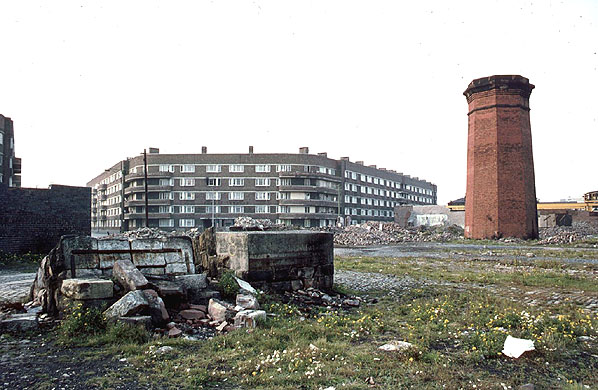 Liverpool Crown Street looking north-west in the late 1970s. The Wapping tunnel ventilation shaft dominates the scene of dereliction. Photo by Chris Coulter from his Flickr photostream .jpg) The site of the Liverpool Crown street passenger station seen from a similar viewpoint as the 1831 Thomas Berry painting on 8 April 2014. The Wapping tunnel ventilation shaft seen to the right was not present in 1831. Photo by Paul Wright .jpg) Surviving railway gate posts at Liverpool Crown Street on 8 April 2014. The posts were located just to the north of the passenger station and provided access into the goods yard that later became known as 'the agricultural yard'. Photo by Paul Wright
 Home Page Home Page
|

